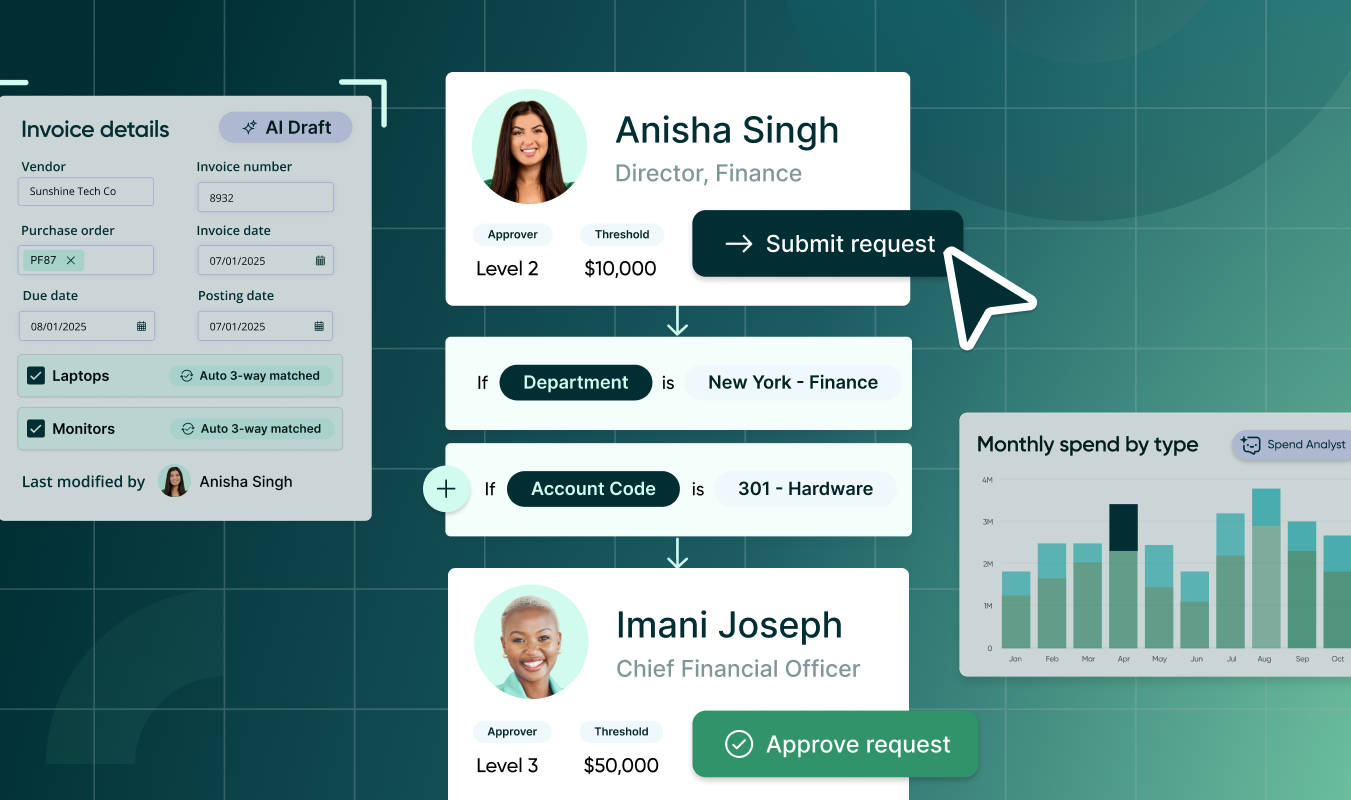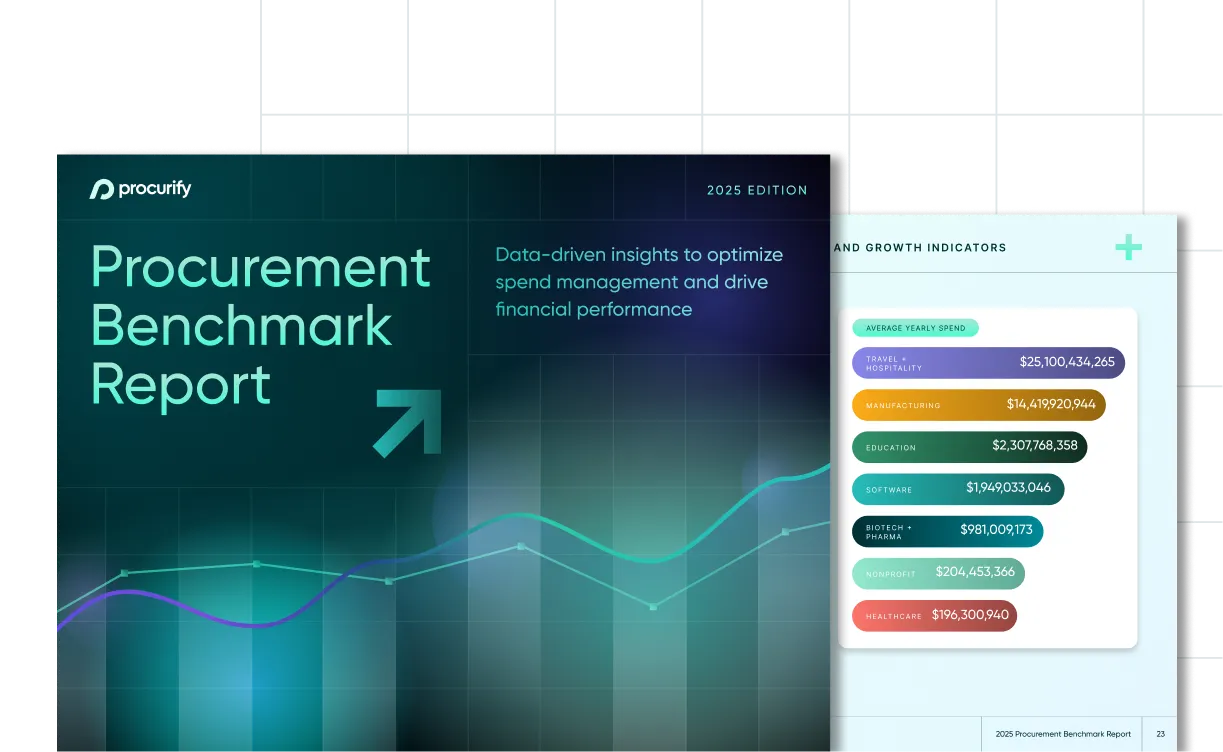
Procurement Best Practices: 3 Fixes That Actually Work
The single biggest predictor of stalled procurement isn’t tool complexity or team size. It’s whether your intake process reflects how people actually make decisions inside your organization.
Most systems are designed around ideal workflows. But procurement doesn’t happen in ideal workflows. It happens in Slack threads, hallway conversations, email chains, and quick approvals while someone is boarding a flight. If your process doesn’t account for that behavior and doesn’t meet people where they already work, chances are your procurement process is stalling.
The teams making real progress aren’t just standardizing intake. They’re embedding it into the moments where spend decisions begin. That’s what improves visibility and control. Not dashboards. Not policies. Execution at the start of the process.
This blog shares three procurement best practices from the Mid-Market Procurement Playbook, based on how mid-sized teams are fixing the gaps between policy and practice. If you’re rethinking how your procurement strategy needs to evolve in 2026, start here.
The biggest procurement bottlenecks
If you lead or support procurement at a mid-sized organization, you’ve likely encountered one (or all) of these issues:
- “Why is our procurement process still so manual?”
- “Why are approvals always stuck in someone’s inbox?”
- “Why can’t finance see spend until it’s too late?”
These aren’t isolated frustrations—they reflect three of the biggest bottlenecks holding procurement back:
- Unstructured intake – When requests start in email, Slack, or hallway conversations, they bypass policy checks, budget controls, and audit trails. This creates invisible spend and manual cleanup.
- Approval delays – Without a clear, automated routing system, approvals often depend on nudges and follow-ups. Requests stall, timelines slip, and stakeholders lose visibility.
- Reactive finance – When finance only sees spend at the PO or invoice stage, they can’t forecast accurately or help guide purchasing decisions proactively.
These breakdowns happen when tools and processes aren’t designed for your organization’s size, pace, or people. And while they may feel like operational snags, they result in strategic drag: slower decisions, weaker compliance, and missed savings.
Best practice: Standardize intake to unblock approvals
Run a bottleneck audit. Map your current intake and approval flows to identify where delays, duplications, or shadow processes exist. Use workflow analytics or internal feedback to understand where requests drop off or stall. Then standardize your intake: consolidate request methods, define approval roles, and implement a digital intake hub that tracks and routes requests automatically. The goal is to create a single, structured entry point for all purchases, enabling early-stage control and visibility.
What procurement tools work best for mid-market teams?
Most mid-sized organizations are using procurement software designed for enterprises. That means long implementations, steep learning curves, and rigid processes. And it shows. What works in a Fortune 500 company can paralyze a 200-person organization. You end up with tools that require change management just to get a purchase approved.
In the playbook, Mitra Chem shares how they ditched their patchwork approval process and adopted a streamlined intake system. The result? Real-time visibility without slowing down operations—or needing to expand the team.
Best practice: Choose modular, mid-market-friendly tools
Choose tools built for your scale and structure. Prioritize modular platforms that allow teams to start small and expand functionality over time. Look for user interfaces designed for non-technical staff and systems that can integrate easily with your finance stack (e.g., budgeting, accounting, AP). Avoid overly rigid ERPs that force your process to fit their mold—instead, opt for solutions that mold to your workflow. Also, involve end users (not just IT and procurement) in evaluating ease of use and day-to-day functionality.
Bonus tip: Involve cross-functional stakeholders in the selection process. What works for procurement must also work for operations, finance, and IT. Need help navigating the landscape? Check out this spend management software buyer’s guide.
How to improve procurement visibility where spend starts?
Too many teams think spend insight starts in a dashboard. But by the time data hits the dashboard, it might already be too late.
The real control point? Intake.Every purchase starts as a request. If that request bypasses your system, you lose:
- Budget context
- Policy enforcement
- Accurate forecasting
When intake is structured to happen before a dollar is spent finance and procurement gain the visibility to guide decisions, not just report on them. Modern intake workflows do more than collect requests—they act as the first line of defense for compliance, budget alignment, and policy enforcement.
Best practice: Gain visibility where spend starts
Build intake workflows that pull in real-time budget data, pre-validate vendor or category selections, and enforce routing rules based on role, amount, or GL code. Use structured fields (not free text) to ensure consistency and reduce data cleanup later. Tie intake directly to approval policies and reporting systems so spend visibility starts before the purchase order—not after. Teams that do this well gain early awareness, better forecasting accuracy, and faster approvals. Start by replacing informal request channels (like Slack or email) with a centralized intake form that feeds your procurement system.
How to automate your procurement process
Automation helps only when it’s embedded where people actually get stuck—not tacked on after the fact.That means removing friction—like auto-routing approvals or flagging out-of-policy items in real time. Not building another reporting layer that no one uses.In the white paper, teams describe how automation helped them move from reactive to proactive. By embedding policy into approvals and using AI to support execution they saved time, improved compliance, and unlocked better forecasting.
The key is functional automation—solutions that integrate seamlessly with how people already work, not require them to change how they work.
Best practice: Apply AI and automation to your spend management
Focus automation on bottlenecks. Identify the high-friction steps that slow requests: approvals, categorization, and policy enforcement. Use automation to route based on role, flag exceptions, auto-assign GL codes, and trigger alerts when budgets are exceeded. Where possible, layer in AI based procurement tools to suggest spend categories, recognize recurring vendors, or flag anomalies. Don’t automate for the sake of efficiency alone—prioritize automation that enhances compliance, reduces manual entry, and supports decision-making at the point of action.
Final thought: Strategy is rarely the problem, execution is
According to The Hackett Group’s 2025 Pulse Check, nearly half of organizations expect flat or declining procurement savings—even though they’ve set clear goals. That’s because strategy without execution is just a plan. And disconnected tools, manual workarounds, and reporting delays are slowing progress.
The fix?
- Use tools built for your team not the enterprise.
- Make intake your visibility and control point.
- Automate the parts of the process where humans get stuck.
Want to see how real mid-market teams are solving these challenges?
Download the full Mid-Market Procurement Playbook for tactical examples and smarter execution strategies.

2025 Procurement Benchmark Report
Powered by $20B+ in proprietary data you won’t find anywhere else.
